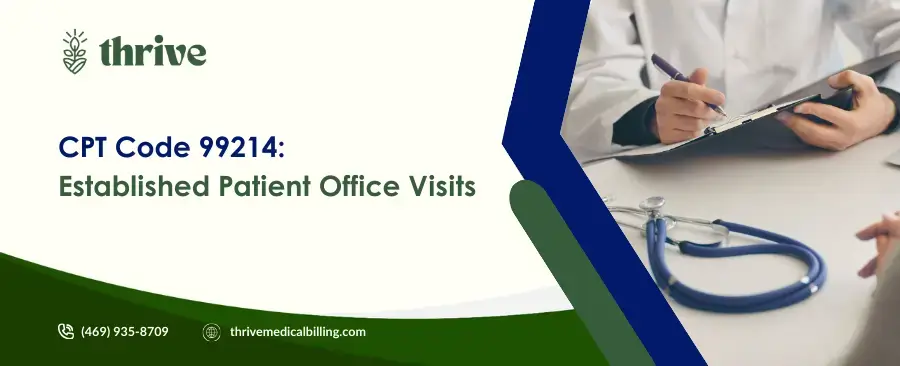Introduction to CPT Code 99214 Definition
CPT code 99214 is a procedural code used in medical billing to describe an evaluation and management (E/M) service for an established patient during an office visit or other outpatient encounter, typically requiring a moderate level of medical decision-making or 30–39 minutes of total time spent on the date of the encounter. This code is part of the Current Procedural Terminology (CPT) system maintained by the American Medical Association (AMA) and is widely used in primary care, specialty practices, and outpatient settings. Understanding the CPT code 99214 definition is essential for physicians, healthcare providers, and billing professionals to ensure accurate billing and avoid issues that lead to claim denials.
This guide provides a detailed overview of CPT code 99214, its applications, modifiers, Medicare reimbursement rates, and strategies to optimize billing for office visits addressing various medical conditions.
What is CPT Code 99214 and Evaluation and Management?
CPT code 99214 represents an evaluation and management (E/M) service provided to an established patient—someone who has received professional services from the physician or another physician in the same group and specialty within the past three years. It is typically used for office visits that involve:
- A moderate level of medical decision-making (MDM), based on the complexity of the problem(s) addressed, data reviewed, and risk of complications or morbidity.
- OR 30–39 minutes of total time spent on the date of the encounter, including face-to-face and non-face-to-face activities (e.g., reviewing records, documenting, or coordinating care).
This code is commonly used in primary care, internal medicine, family practice, and specialty clinics for managing moderately complex conditions, such as multiple chronic illnesses or acute conditions requiring detailed evaluation. CPT code 99214 is one of the most frequently billed E/M codes due to its applicability to a wide range of outpatient encounters requiring moderate clinical effort.
Procedure Involving CPT Code 99214
The procedure involving CPT code 99214 includes the following components, as defined by the AMA’s E/M guidelines:
- History Taking: The physician collects a detailed history, including the patient’s chief complaint, an extended history of the present illness, a review of systems, and pertinent medical, social, or family history.
- Physical Examination: A detailed examination of the affected body area or organ system, along with other related systems, is performed to assess the patient’s condition.
- Medical Decision-Making (MDM): The physician evaluates the patient’s condition, reviews relevant data (e.g., labs, imaging, test results), and makes decisions about diagnosis, treatment, or follow-up care. For 99214, MDM is typically moderate, involving multiple diagnoses, moderate data complexity, or moderate risk of complications.
- Time-Based Billing (Optional): If time is used instead of MDM, the physician spends 30–39 minutes on the encounter, including activities like counseling, coordinating care, or documenting in the medical record.
- Documentation: The physician documents the history, exam, MDM, or time spent to support the level of service billed.
The procedure occurs in an outpatient setting, such as a physician’s office, clinic, or telehealth visit (when permitted by payers). CPT code 99214 is used for established patients with conditions requiring a higher level of clinical effort than lower-level codes like 99213.
Comparison with Related CPT Codes
CPT code 99214 is part of the E/M code set for office or outpatient visits, which varies based on patient status (new or established), level of service, and complexity. Here’s how it compares to related codes:
- CPT Code 99212: Represents an E/M service for an established patient with minimal or straightforward MDM or 10–19 minutes of total time, used for minor or self-limiting problems.
- CPT Code 99213: Covers an E/M service for an established patient with low to moderate MDM or 20–29 minutes of total time, used for less complex conditions than 99214.
- CPT Code 99215: Describes an E/M service for an established patient with high MDM or 40–54 minutes of total time, used for severe or complex conditions.
- CPT Code 99204: Represents an E/M service for a new patient with moderate MDM or 45–59 minutes of total time, distinct from 99214 for established patients.
- CPT Code 99396: Covers a preventive medicine visit for an established patient aged 40–64, unlike the problem-oriented focus of 99214.
Choosing the correct procedural code is critical to ensure accurate billing. For example, billing CPT code 99214 for a visit with low complexity (99213) or a new patient (99204) can lead to claim denials.
Modifiers for CPT Code 99214
Modifiers provide additional context for CPT code 99214 to ensure proper reimbursement. The following modifiers are sourced from authoritative references, including the AMA’s CPT Professional Edition and CMS’s National Correct Coding Initiative (NCCI) Policy Manual:
- Modifier 25 (Significant, Separately Identifiable E/M Service): Used when a separate procedure (e.g., minor surgery, injection like CPT code 20610) is performed on the same day as the office visit. For example, treating a skin lesion and managing diabetes during a 99214 visit.
- Modifier 95 (Synchronous Telemedicine Service): Applied when CPT code 99214 is provided via telehealth, if permitted by the payer, per CMS and AMA telehealth guidelines.
- Modifier 24 (Unrelated E/M Service During Postoperative Period): Indicates an E/M service unrelated to a prior procedure’s postoperative period, as outlined in the AMA’s CPT guidelines.
- Modifier 57 (Decision for Surgery): Used when the 99214 visit results in a decision for major surgery, though less common with this code, per CMS’s NCCI edits.
- Modifier 99 (Multiple Modifiers): Applied when multiple modifiers are needed, as per AMA standards.
Providers must adhere to AMA and payer guidelines, including Medicare’s NCCI edits, to avoid errors that lead to claim denials. These modifiers are verified against the CPT Professional Edition (2025) and CMS’s NCCI Policy Manual (2025) to ensure accuracy.
Medicare Reimbursement Rates for CPT Code 99214
CPT code 99214 is reimbursable by Medicare, but reimbursement rates vary based on several factors:
- Medicare Physician Fee Schedule (MPFS): The MPFS provides payment rates for CPT code 99214, adjusted by the Geographic Practice Cost Index (GPCI) for regional cost differences, as outlined by CMS.
- Medicare Administrative Contractors (MACs): Regional MACs may impose specific billing rules or coverage criteria, such as Local Coverage Determinations (LCDs) for E/M services.
- Non-Facility vs. Facility Rates: Non-facility rates (e.g., private offices) are higher to account for overhead costs, while facility rates (e.g., hospital outpatient clinics) are lower, per the CMS MPFS.
- Telehealth Eligibility: Medicare may cover CPT code 99214 for telehealth visits, depending on temporary or permanent coverage policies in 2025, as specified in CMS guidelines.
To verify reimbursement rates for 2025, providers should:
- Check the MPFS on the Centers for Medicare & Medicaid Services (CMS) website.
- Consult their regional MAC for specific coverage policies and billing rules.
- Use coding tools like AAPC Coder or Kareo for rate estimates.
Accurate documentation of medical necessity, such as managing multiple chronic conditions like hypertension and diabetes, or addressing acute issues requiring moderate complexity, is critical for Medicare reimbursement, per CMS’s Medicare Claims Processing Manual.
Conditions Addressed with CPT Code 99214
CPT code 99214 is used to address a wide range of medical conditions during office visits for established patients, requiring moderate complexity. Examples include:
- Multiple Chronic Conditions: Managing conditions like hypertension, diabetes mellitus, chronic obstructive pulmonary disease (COPD), or heart failure with adjustments to treatment plans.
- Acute Conditions: Treating moderately complex issues, such as pneumonia, urinary tract infections, or acute musculoskeletal injuries.
- Follow-Up Care: Monitoring progress for conditions like depression, anxiety, or post-surgical complications requiring detailed evaluation.
- Complex Symptom Evaluation: Assessing symptoms like chest pain, fatigue, or abdominal pain that require moderate diagnostic workup or data review.
- Medication Management: Adjusting medications for conditions like epilepsy, thyroid disorders, or chronic pain.
The moderate complexity of CPT code 99214 makes it suitable for primary care and specialty encounters involving multiple diagnoses or detailed clinical decision-making.
Medical Billing Best Practices to Ensure Accurate Billing
To ensure accurate billing for CPT code 99214 and minimize issues that lead to claim denials, providers should adopt the following medical billing strategies:
- Train Staff: Educate billing staff on the CPT code 99214 definition, its differences from other E/M codes (99213, 99215), and appropriate modifiers, using resources like the AMA’s CPT Professional Edition.
- Use EHR Systems: Electronic health records like Epic, Cerner, or eClinicalWorks streamline documentation and coding for office visits.
- Document Medical Necessity: Clearly note the detailed history, exam, MDM, or time spent to justify the moderate complexity of 99214, aligning with AMA and CMS guidelines.
- Verify Payer Guidelines: Confirm Medicare and private payer rules for CPT code 99214, especially regarding telehealth, frequency, and modifier use.
- Conduct Regular Audits: Review claims to ensure compliance with E/M guidelines and identify errors, using tools like AAPC Coder or internal audit processes.
These practices optimize revenue cycle management and improve financial outcomes for primary care and specialty practices.
Common Errors That Lead to Claim Denials
Billing errors for CPT code 99214 can lead to claim denials, delaying reimbursement. Common mistakes include:
- Incorrect Code Selection: Billing CPT code 99214 for a visit with low complexity (99213) or high complexity (99215), or for a new patient (99204).
- Improper Modifier Use: Applying Modifier 25 without a separate, significant procedure or using Modifier 95 for non-covered telehealth visits, per CMS’s NCCI Policy Manual.
- Inadequate Documentation: Failing to document the detailed history, exam, MDM, or time required to support 99214, leading to downcoding or denials.
- Unbundling Errors: Billing CPT code 99214 with other E/M codes or procedures without justification, violating NCCI edits.
- Non-Compliance with Payer Policies: Not adhering to Medicare or private payer rules for visit frequency, medical necessity, or telehealth eligibility.
Providers should verify codes, modifiers, and documentation to ensure accurate billing and avoid denials, aligning with AMA and CMS standards.
Conclusion and Resources
CPT code 99214 is a critical procedural code for evaluation and management services during office visits for established patients, addressing moderately complex conditions like multiple chronic diseases or acute illnesses in primary care and specialty settings. By understanding the CPT code 99214 definition, its modifiers, Medicare reimbursement rates, and best practices for medical billing, providers can ensure accurate billing and minimize issues that lead to claim denials. For further guidance, consult:
- CMS Website: For MPFS, NCCI edits, and reimbursement rates.
- American Medical Association (AMA): For CPT code updates and E/M guidelines.
- American Academy of Family Physicians (AAFP): For resources on primary care and evaluation and management coding.
By staying informed and proactive, healthcare providers can optimize billing for CPT code 99214 and enhance patient care through effective outpatient services.








